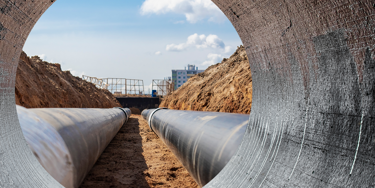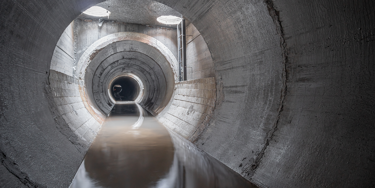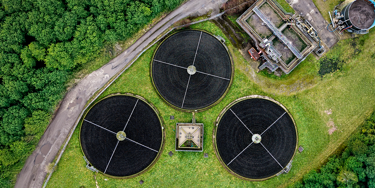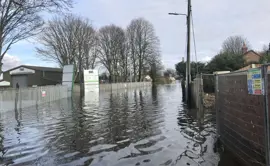Tackling infiltration, misconnections and blockages to unlock hidden hydraulic capacity in wastewater networks
Published 30 April 2025
Despite increased regulations and significant investment, pollution and flooding performance in the UK’s wastewater network remain pressing issues. Ageing infrastructure, climate change, and growing populations are pushing the limits of existing systems. While proactive sewer rehabilitation helps maintain parts of the network, factors such as misconnections and infiltration continue to drive pollution and flooding events.
To build a more resilient wastewater network, water companies must take a proactive approach to identifying and resolving these hidden threats. Focusing on increasing network capacity through additional storage may seem like a solution, however, this approach may only provide short-term relief and can be costly and carbon intensive.
Unlocking hidden hydraulic capacity within the network could offer a long-term, cost-effective, and environmentally responsible solution. By optimising existing assets (particularly specialist, often neglected assets in the network) through targeted interventions like infiltration reduction, blockage removal, and misconnection management, water companies can enhance flow efficiency, reduce pollution events, and prevent flooding without the need for new infrastructure.
Data is also critical. Advanced monitoring technologies, predictive analytics, and proactive intervention can drive efficiency. Better data will ensure that networks operate closer to their full potential while meeting regulatory targets and customer expectations. It will also provide water companies with better planning data for future investment, so that increases to capacity are well targeted, considering the cost of capital and carbon.
Shifting the focus from expansion to smarter utilisation of current assets can help create a more resilient, adaptable wastewater network capable of handling future demands.
The challenge of managing an increasingly overburdened network
Many water companies are struggling with persistent flooding and pollution issues, particularly during heavy rainfall. Excess water, including surface water, overwhelms the system, leading to increased spills.
However, the root causes are not always clear-cut. Infiltration, misconnections and blockages all play a role in reducing hydraulic capacity, but they can be difficult to detect without proper monitoring. Left unaddressed, these issues not only impact network performance but also lead to environmental harm and regulatory non-compliance.

As we enter AMP8 (Asset Management Period 8), financial penalties for underperformance are growing, and the pressure to deliver measurable improvements has never been greater. Water companies must take a strategic and data-driven approach to ensure assets are operating at their intended capacity. Investing in smart monitoring solutions, predictive analytics, and targeted intervention strategies will be key to identifying issues early and preventing costly pollution events.
Infiltration, misconnections and blockages are three major contributors to reduced hydraulic capacity. By tackling these, water companies can take proactive steps toward reducing pollution, mitigating flood risks, and building a more resilient wastewater network for the future.
Infiltration: preventing groundwater from overloading the network
Infiltration occurs when groundwater seeps into the sewer system through ageing pipes. This increases the volume of water that must be treated, placing unnecessary strain on treatment plants, reducing overall network capacity, and increasing operational costs and carbon emissions.

Infiltration can be particularly problematic in areas with high groundwater levels, where sustained infiltration can lead to chronic performance issues and increased pollution risks.
The solution
- Investigating infiltration hotspots using network monitoring and flow analysis
- Lining, sealing and maintaining pipes to prevent groundwater entry and prolong asset life (using innovative technology to reduce cost and impact on customers)
- Implementing a proactive maintenance strategy to prevent minor defects from escalating, based on data from monitors in the network
By addressing infiltration, water companies can improve system efficiency, reduce unnecessary treatment costs, and free up hydraulic capacity without major infrastructure investments. Taking a targeted, data-led approach ensures that remediation efforts deliver the greatest benefit while supporting compliance with tightening regulatory standards.
Although many see infiltration as the issue for AMP8, data and experience tells us that it can often be easy to assume pollution in the network is caused by infiltration, when our experience indicates that this can often be caused by misconnections.
Misconnections: a hidden drain on sewer capacity
Misconnections occur when pipes discharge wastewater or surface water into the wrong sewer.
Misconnections can be difficult to detect as they often occur within private properties or go unnoticed in older drainage systems. It can also happen in new developments; despite Section 42 legislation being in place as a safeguard, misconnection events still occur. Left unresolved, they can significantly impact network performance and compliance with environmental regulations.
There are three main types of misconnections:
- Foul water misconnections: Foul connections entering storm drains at any point in the network
- Storm water misconnections (permitted): Storm connections entering a combined sewer system
- Storm water misconnections (not permitted): Foul water sewer networks with storm connections made later, where surface water systems are not available
This often results in rainwater and surface water entering foul sewers, overloading the system, increasing treatment costs, and contributing to unnecessary spills during heavy rainfall.
This creates two distinct issues. First, surface water discharged into foul sewers leads to unnecessary treatment, driving up costs, and reducing system efficiency. Second, if foul water enters surface water drains, it bypasses treatment facilities and flows directly into rivers, causing pollution and environmental damage.
The solution
- Implementing advanced network monitoring and misconnection surveys to pinpoint issues
- Conducting targeted investigations in high-risk areas to identify and prioritise remedial action
- Working with property owners to rectify misconnections and ensure compliance with drainage regulations
- Raising public awareness about misconnections and their impact on flooding and pollution
By preventing rainwater from unnecessarily entering the sewage system, companies can free up valuable capacity, enhance wastewater treatment efficiency, and reduce pollution incidents. Likewise, reducing foul drain misconnections helps prevent hidden pollution sources that can only be detected through investigation. When an unregulated discharge occurs outside the treatment works, tracing it back through the network is essential to identify its source.
Taking a proactive approach to misconnection management will help meet performance targets and regulatory requirements while improving environmental outcomes.
Blockages: clearing the path for maximum flow
Blockages are a major hidden threat to the efficiency of the wastewater network, often forming in public sewers and laterals that connect to customers' homes.
The typical approach to managing blockages is through planned preventive maintenance that focuses on high-risk areas in the network, and reactive works that address issues as and when they arise. This approach risks overlooking parts of the network that represent significant hydraulic pinch points in the network such as syphons and trunk sewers.

Many water companies lack accurate data for syphons, making them difficult to monitor. Due to their unique design, debris can easily get trapped, leading to unexpected spills and capacity reductions. Without proper maintenance, syphons can quickly become a hidden bottleneck, restricting flow and greatly increasing the risk of pollution events.
Trunk sewers, which serve as the final pathway before treatment works, accumulate silt, fats, oils and other debris over time. Waste flushed from upstream builds up, gradually blocking the system and drastically reducing capacity. This not only increases the likelihood of spills but also forces treatment plants to operate less efficiently, raising operational costs.
In extreme cases, severe blockages can lead to network failures, resulting in environmental damage and regulatory penalties.
The solution
- Conducting proactive, risk-based cleaning of syphons and trunk sewers to remove debris and restore capacity
- Implementing a proactive maintenance strategy that prioritises high-risk assets
- Using advanced monitoring technology to track sediment build-up and predict when cleaning is required
- Improving network mapping to accurately locate and maintain syphons
By prioritising regular inspection and cleaning, water companies can unlock hidden hydraulic capacity, prevent spills, and improve overall network resilience.
A well-maintained sewer system not only ensures compliance with environmental regulations but also enhances long-term operational efficiency, reducing costs and improving service reliability.
A smarter way forward: a holistic approach
Rather than relying solely on increasing storage or adding storm overflows, optimising existing assets provides a sustainable, cost-effective approach to pollution reduction.
By tackling infiltration, misconnections and blockages head-on, water companies can unlock hidden capacity, improve compliance, and protect the environment – all without costly infrastructure expansion.
Each catchment presents unique challenges; some may experience higher levels of infiltration, others more misconnections, while urban areas may struggle with blockages from fatbergs. A holistic, tailored approach is essential, as a single solution will not work for all areas.
Investing in proactive asset management not only enhances network performance but also helps future-proof wastewater infrastructure against increasing regulatory pressures, climate change, and population growth. A smarter, data-driven approach to wastewater management is essential for ensuring long-term resilience and sustainability.
By leveraging advanced monitoring technologies, data-driven decision making, and targeted intervention strategies, water companies can achieve greater operational efficiency while meeting stringent regulatory requirements.
More from our Knowledge Hub
Environmental compliance today, creating a sustainable tomorrow
Helping you reduce risk to the environment and your operation by managing assets compliantly while achieving commercial, ESG, and net-zero goals.
Contact our experts




